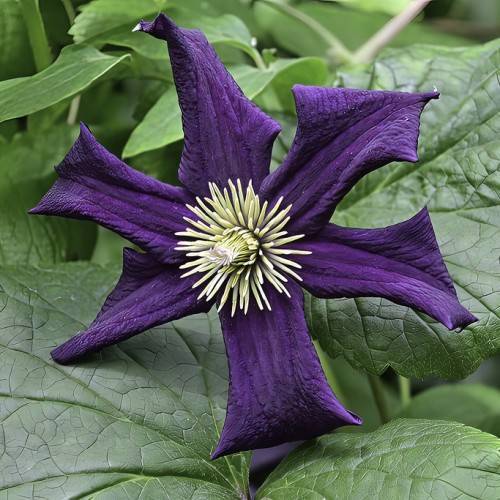
clematis
Clematis 'Evipo030' BIJOU
Cycle:
Herbaceous Perennial
Watering:
Average
Hardiness Zone:
4 - 8
Flowers:
Flowers
Sun:
Full sun,part shade
Leaf:
Yes
Growth Rate:
High
Maintenance:
Low
Care Level:
Medium
watering
This particular Clematis 'Evipo030' BIJOU should be watered deeply but infrequently. Aim to water your clematis twice a week during the growing season, when the weather is hot and dry and/or if the plant shows signs of wilting. Avoid frequent shallow watering – this can cause root rot and will encourage the plant to produce more leaves than they can sustain. Make sure to check the soil; if it is dry approximately 4 inches below the surface, then it's time to water. In the hotter months, you may need to increase your watering frequency. In the winter, you may need to decrease frequency and only water if the soil is dry.
sunlight
Clematis 'Evipo030' BIJOU plants do best when they receive 4-6 hours of sunlight per day. It is important to pay attention to how much direct sunlight the plant receives over the course of a day, as it can burn easily in strong afternoon light. Morning light is best since it encourages earlier flowering. During the summer months, it may be beneficial to provide some light shade for the plant in the afternoon to prevent leaf burn.
pruning
Clematis 'Evipo030' BIJOU should be pruned twice a year: once in late winter and again in midsummer. In late winter when the plant is dormant, prune away any dead, damaged, or diseased stems. Leave around 6 of the strongest, healthiest stems and prune them back to about 30 cm (12 inches). In midsummer, prune any stems that have cooled, are leggy, have too strong a vine habit, or are stunted. This can be done to a height of around 30 cm (12 inches) as well. Always be sure to prune above healthy buds to ensure the most new blooms.
FAQ
Can Clematis plants grow in pots?
Yes, Clematis plants can definitely be grown in pots. When planting a Clematis in a pot make sure to use a larger size pot with drainage holes and fill it with a mix of well-draining potting soil and compost. Ensure to keep the root area cool and the pot in a sunny location while providing regular water and fertilization. Check the plant almost daily to make sure it is not becoming too dry. Clematis can do well in a pot and with the right care and conditions, they will thrive.
Are Clematis plants self-pollinating?
No, clematis plants are not self-pollinating. Clematis plants need pollinators such as bees, butterflies, moths and other insects to transfer pollen from the male anthers to the female stigma of the flower in order to produce viable seed. Pollination must also occur within relatively close proximity of the same species in order to create viable hybrid plants.
Can Clematis plants be grown as a houseplant?
Yes, Clematis plants can be grown as a houseplant. It is best to grow them in a pot with full sun and a soil that is rich in organic material and retains moisture. When potting the plant, place a stake or trellis next to the pot so that the vine can climb when it begins to grow. Be sure to water your Clematis plant regularly to keep it healthy and growing. Additionally, keep an eye out for pests and treat with natural insecticides as necessary.
Could Clematis plants survive in a colder climate?
Yes, Clematis plants can survive in colder climates with proper preparation. If planted in the fall, proper mulching should be done to protect the roots from cold temperatures. If planted in the spring, they should be watered frequently to help them adjust to the cooler temperatures more quickly. If temperatures drop below -20°C ( -4°F), additional measures may need to be taken such as the application of protective wraps and thermal insulation. Additionally, plants in exposed areas should be protected from the wind to prevent excessive dehydration. With the right measures in place, Clematis plants can easily survive in colder climates.
Could Clematis plants be grown in a greenhouse?
Yes, clematis plants can be grown in a greenhouse. Due to their vine-like growth habit and tropical native origins, clematis plants thrive in the moist and warm environment of a greenhouse. Clematis are generally grown from cuttings or from dividing existing plants, and benefit from regular pruning and fertilizing. They will also enjoy the indirect light of a greenhouse and the protection from strong winds and temperatures that the humidity and contained environment provides.
